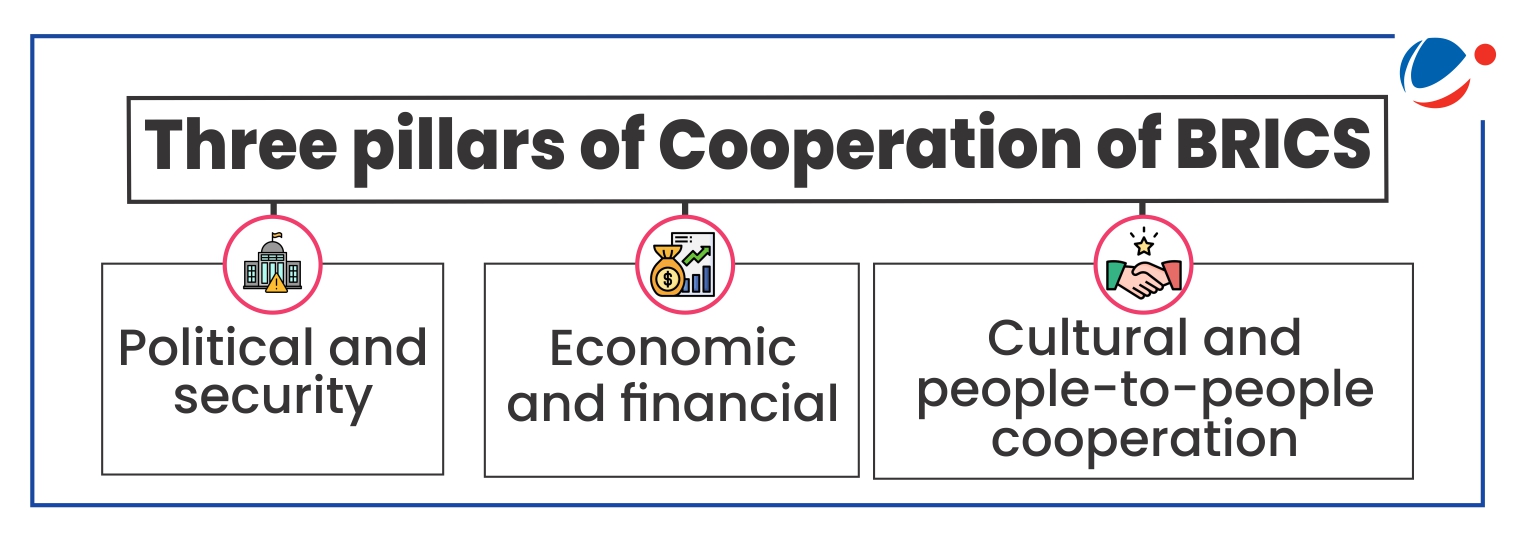Why in the News?
16h BRICS Summit, and the First Summit with expanded BRICS membership was held in Kazan (Russia).
About the Summit
- Adoption of Kazan Declaration: "Kazan Declaration: Strengthening Multilateralism for Just Global Development and Security" was adopted.
- Extend full support to Brazil for its BRICS Chairship in 2025 and the holding of the 17th BRICS Summit in Brazil.
About BRICS
- Genesis: British economist Jim O' Neill in 2001 coined acronym 'BRICs' representing the emerging economies of Brazil, Russia, India, and China.
- BRIC started functioning as a formal grouping on the margins of G8 Outreach Summit in 2006. 1st BRIC Summit was held in Russia in 2009. BRIC became BRICS with the inclusion of South Africa in 2010.

- Members (10):
- Initial 5 members (BRICS): Brazil, Russia, India, China, South Africa and
- 5 new members (BRICS+): Egypt, Ethiopia, Iran, Saudi Arabia, and the United Arab Emirates.
- It represents:
- 45% of the world's population.
- 37.3% of world GDP (compared to EU's 14.5 % and the G7's 29.3%)

Key Initiatives of BRICS
Area | Initiatives |
| Financial |
|
| Voice to Global South |
|
| Security |
|
| S&T |
|
Relevance of BRICS in contemporary world
- Energy Security: With Iran, Saudi Arabia and UAE as members, BRICS countries produce about 44% of the world's crude oil.
- Voice for global south: BRICS acts as a platform for India to raise concerns and advocate for the rights of developing countries acting as a leader of global south on issues such as terrorism, climate change.
- Safe space for dialogue: BRICS provides neutral platform for India to engage in dialogue and manage potential rivalries, even during times of bilateral tensions (India-China Doklam standoff).
- Boosting multilateral reform demands: It allows India to push for reforms in institutions such as UNSC and WTO for ensuring equitable global order.
- With the exception of Ethiopia and Iran, all BRICS+ countries are WTO members.
Challenges associated with BRICS
The formation of BRICS was rooted in the long-term common economic interests of the member countries, but it has yet to reach its full potential due to various challenges, including:
- Underutilisation of Economic Potential: For example,
- Intra-BRICS Trade: While BRICS countries collectively account for 18% of global trade, intra-BRICS trade remains low at just 2.2% (as of 2022). Geographical separation and dominance of China in trade is a key issue.
- BRICS Credit Rating Agency (CrRA): It was proposed in 2018 but was not taken up due to a lack of consensus among members.
- Dedollarisation: Some members like Iran, Russia, and China, now trade in their own currencies. Although there's talk of a common BRICS+ currency, experts see this as unlikely, especially with the group's recent expansion.
- Inability to create alternative Global Financial Institutions: NDB lacks the funds needed to match the reach and impact of the World Bank and IMF or the Asia Infrastructure Investment Bank (AIIB) which was initiated by China in 2013.
- Unlike the AIIB, which co-finances projects with the World Bank, Asian Development Bank (ADB), etc. the NDB has limited partnerships and co-financing arrangements.
- Inability to influence Global Institutions: For example, BRICS+ countries collectively hold only about 19% of voting power within the International Bank for Reconstruction and Development (IBRD), compared to about 40% held by G7 countries and about 23% by EU-27 nations.
- On the other hand, India and Brazil were the largest recipients of IBRD loans in 2023, yet contributed just 5 % of the capital. This imbalance undermines BRICS+ efforts to influence international financial standards and policies.
- Inability to stand as a cohesive block: Geopolitical rivalries exist between BRICS members such as between India and China or Saudi Arabia and Iran which limit the group's ability to function as a unified entity on global issues.
- Member economies are no longer booming: For example, China is struggling from economic slowdown whereas Russia has been in decline for years and the ongoing war will enfeeble it further.
- South Africa also remains saddled with high unemployment and profound governance and fiscal challenges.
- Perception of being an Anti-West organisation potentially limiting cooperation in areas of shared interest such as climate change, trade, and global security.
- Existence of similar groupings: For example, Unlike BRICS, which includes a diverse range of political systems, IBSA consists of democracies that may find it easier to establish a shared agenda and foster cooperation.
- Similarly, BASIC is also considered to be more cohesive group than BRICS.
About IBSA
About BASIC
|
Way Forward
- Develop Clear and Shared Vision: Outlining long-term goals and objectives will help align diverse interests of member states and foster a sense of unity. Setting up of a permanent secretariat is also needed.
- Such vision should facilitate the larger BRICS to challenge the dominance of existing global institutions, such as the World Bank and the International Monetary Fund, that are strongly influenced by the West.
- Defining membership criteria: Advocating a clear membership criterion for BRICS will help ease India's concerns about who could be future members of the BRICS.
- Consensus-Building: Prioritize diplomacy and dialogue to resolve differences and build consensus among member states.
- Enhanced Institutional Capacity: Strengthen the institutional capacity of BRICS+ to support its operations and making its initiatives including NDB, BRICS-Pay etc. more effective.
- Checking Chinese influence: India needs to balance the strategic influence that China exerts in the BRICS grouping with its economic diplomacy and its relations with Russia and Iran.
Conclusion
The success of BRICS+ will depend on how well members overcome internal differences, find common ground, and leverage their strengths. While expansion offers more greater representation in global governance, realizing its potential will require strong cooperation and effort.








